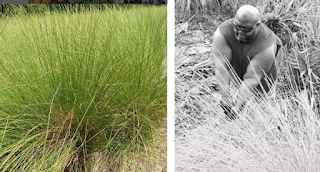Yesterday's Textiles and Tea featured Corey Alston, wonderful fifth generation Gullah basket maker, whose wife and daughter also continue the tradition.
It stems from enslaved West African people, forcibly shipped to the Carolinas, mostly via Charleston, to exploit their skills in growing rice. They found the native sweetgrass similar to the West African grasses they used to weave baskets needed for winnowing the rice harvest, and adopted them, to continue making the baskets. They also use cattails and other grasses, for contrasting color.
They're functional and an artform, as you see. He does a lot of teaching and speaking, to keep the Gullah culture known, and can be found at Charleston Market, weaving his baskets and answering questions, as well as selling. He harvests and dries his own supplies of grasses, which he works, stitching with split palm leaves, to create his artworks. He encourages buyers to handle and use them, not just hang them on the wall!

















Wow, those baskets are gorgeous!
ReplyDeleteHe was working on one while he talked!
Deletebig man, big baskets. interesting work.
ReplyDeleteHe's a lovely personality, big and warm, you just want to know him.
DeleteBasketry is such a beautiful and functional art form. Mr. Alston's work is magnificent.
ReplyDeleteHe's a world class artist, I'm glad to extend his reach here. He does things nobody else can approach.
DeleteWhat beautiful baskets - unique I think
ReplyDeleteThey're classic Gullah. They also have a cuisine. And much more
DeleteThose baskets are amazing. Wow. Wow.
ReplyDeleteI just watched in wonder as he worked, talking all the while.
DeleteI just solved the HH puzzle! We have some in my city.
ReplyDeleteYay!
DeleteIs that a universal symbol I wonder. Those baskets are definitely art as well as useful. Beautiful.
ReplyDeleteI've seen it described in the US. There may be one in the UK. You could ask at your local women's shelter?
DeleteAnd did the puzzle! Helped a bit by Debra's clue.
ReplyDeleteWell done!
ReplyDeleteWhat beautiful basket work Corey does. Truly a treasure. I can understand people wanting to display it rather than use it. I think I would use it though.
ReplyDeleteHe explained that if you don't handle and use it ss a container, and wipe it with a damp cloth occasionally, it will dry out and crack. Your hands are good for it, also fruit or other foods.
DeleteSuch a beautiful work of art!
DeleteCathy
I was in South Carolina, near Charleston not long ago and my friend introduced me to native Gullah weavers. I purchased some small baskets for my granddaughter.
ReplyDeleteI hope she handles them!
DeleteThe baskets are really fascinating — so intricate!
ReplyDeletebest, mae at maefood.blogspot.com
I stand in awe at Mr. Alston's functional artistry. And to think that using the baskets will help preserve them - wow! Gullah culture and history is fascinating.
ReplyDeleteAfter being skunked by the last HH puzzle, the answer to this one leapt out at me. Odd how one's brain works.
Chris from Boise
I think that happened to a couple of people. It's like the puzzle function was spring loaded for this one. Alston is a lovely guy, a person you'd love for a friend, talented,. wise and patient with people's ignorance.
DeleteThose baskets are so beautiful and each is a piece of art. Never thought of the possibility of damage happening due to non-use. Thank you for the reminder about the universal distress signal.
ReplyDeleteIt's good to know that signal, just in case you ever see it in action, you'll know your next move.
DeleteSo now you know -- use your priceless baskets!